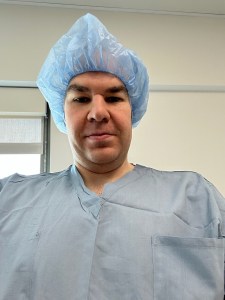
| The JH Explorer series follows our investment teams across the globe and shares their on-the-ground research at a country and company level. |
Approved by regulators within the last few years, pulse field ablation (PFA) systems are off to a promising start as an alternative treatment for atrial fibrillation (AFib), a common type of heart arrhythmia that, if left untreated, can lead to serious risks such as stroke and death.
Investors have been optimistic about the growth potential of PFA, helping lift the stocks of certain device makers. But as with any new medical product, the long-term outlook for PFA depends on more than initial enthusiasm: Is PFA effective, safe, and priced well enough to supplant the previous standard of care?
In search of an answer, in June, I traveled to Chicago as part of select group of investors invited to scrub in and witness PFA procedures performed by Dr. Mark Metzel, a cardiologist who specializes in treating AFib. It was a unique experience, and in my one day with Dr. Metzel, I learned more than I could have in months of research on my own.
Watching efficiency gains in real time
More than 10 million people in the U.S. are estimated to suffer from AFib, with cases expected to rise to 16 million by 2050 as the population ages.1 For decades, doctors treated the condition with either antiarrhythmic drugs or radiofrequency (RF) ablation, a procedure in which a catheter is threaded through a vein to the heart and delivers heat to burn/disrupt cardiac cells causing irregular heartbeats.
PFA is similar to radiofrequency ablation but uses electricity, not heat, to target cells. In clinical studies and in practice, the approach has often led to shorter operating times and reduced damage to surrounding tissues such as the esophagus, leading to rapid adoption.
In 2024, Dr. Metzel’s clinic did 1,000 AFib cases, up 20% from the previous year. Two-thirds of those procedures were done using PFA (compared to the national average, which so far is reported to be closer to one-third).

Tim McCarty, prepping to watch the first pulse field ablation procedure of the day.
Our day started with a procedure involving one PFA called Farapulse, followed by another procedure using competitor Varipulse. Throughout, the efficiency of PFA became clear: on average, the procedure takes about 45 minutes, versus one hour and 15 minutes for RF. (One of the procedures I watched clocked in at 39 minutes). That alone leads Dr. Metzel to believe PFA will likely become the standard of care nationally. “The train has left the station and is not coming back,” he told us.
A surprise revelation
All of which made Dr. Metzel’s next observation more striking: Despite growing patient demand for PFA (thanks, in part, to aggressive marketing), Dr. Metzel said if someone in his family were diagnosed with AFib, he would not rule out using RF. The reason: a shortage of long-term safety data for PFA.
Today, the risks of radiofrequency ablation are well known thanks to decades of commercial use. PFA, by contrast, has been available in the U.S. for less than two years. And while clinical data show PFA may be better when it comes to avoiding acute side effects – including PV stenosis (a narrowing of the heart valves) and atrioesophageal fistula (an often fatal condition in which a connection forms between the heart’s left atrium and esophagus) – other complications have started to emerge.
In one recent study, named NEMESIS, significant increases in proteins such as cardiac troponin (which can indicate heart damage) and lactate dehydrogenase (a sign of tissue disease) were observed in PFA patients versus those treated with RF. These side effects may not be as severe as things like PV stenosis, but they are not inconsequential. “Adoption is clearly ahead of the science,” Dr. Metzel told us.
Revisiting the investment thesis
Does that mean it’s game over for PFA? Certainly not. But it does test Wall Street’s seemingly bulletproof perception of PFA, as well as our own modeling of future growth rates – a reality that may not be fully discounted in the stock prices of PFA manufacturers.
In another variable, Dr. Metzel stressed his clinic is keenly focused on pricing and that there is growing pressure to bring spending on PFA more in line with that of RF. We’ve long believed competition would bring pricing down, but Dr. Metzel’s feedback suggested the timeline could be sooner than expected.
The importance of in-depth research
At the end of the day, my visit to Dr. Metzel’s operating room confirmed my thesis about the efficiency benefits of PFA and that sales momentum is likely to continue. But it also brought up new issues, which require further investigation. Post this trip, we have already spoken to the principal investigator of the NEMESIS trial and other key opinion leaders in the space. Gathering these data points will be important to developing a more robust picture for PFA. It will also help me to not lose sight of the downside risks of PFA – as well as potential opportunities, as companies work to address the pain points of what is, undoubtedly, an exciting new option for AFib patients.
1 American Heart Association Journals, Epidemiology of Atrial Fibrillation in the 21st Century: Novel Methods and New Insights, 18 June 2020 and National Institutes of Health, Atrial fibrillation estimated to affect about 1 in 22 Americans, 12 September 2024.
IMPORTANT INFORMATION
Health care industries are subject to government regulation and reimbursement rates, as well as government approval of products and services, which could have a significant effect on price and availability, and can be significantly affected by rapid obsolescence and patent expirations.
These are the views of the author at the time of publication and may differ from the views of other individuals/teams at Janus Henderson Investors. References made to individual securities do not constitute a recommendation to buy, sell or hold any security, investment strategy or market sector, and should not be assumed to be profitable. Janus Henderson Investors, its affiliated advisor, or its employees, may have a position in the securities mentioned.
Past performance does not predict future returns. The value of an investment and the income from it can fall as well as rise and you may not get back the amount originally invested.
The information in this article does not qualify as an investment recommendation.
There is no guarantee that past trends will continue, or forecasts will be realised.
Marketing Communication.
Important information
Please read the following important information regarding funds related to this article.
- Shares/Units can lose value rapidly, and typically involve higher risks than bonds or money market instruments. The value of your investment may fall as a result.
- Shares of small and mid-size companies can be more volatile than shares of larger companies, and at times it may be difficult to value or to sell shares at desired times and prices, increasing the risk of losses.
- If a Fund has a high exposure to a particular country or geographical region it carries a higher level of risk than a Fund which is more broadly diversified.
- The Fund is focused towards particular industries or investment themes and may be heavily impacted by factors such as changes in government regulation, increased price competition, technological advancements and other adverse events.
- The Fund may use derivatives to help achieve its investment objective. This can result in leverage (higher levels of debt), which can magnify an investment outcome. Gains or losses to the Fund may therefore be greater than the cost of the derivative. Derivatives also introduce other risks, in particular, that a derivative counterparty may not meet its contractual obligations.
- If the Fund holds assets in currencies other than the base currency of the Fund, or you invest in a share/unit class of a different currency to the Fund (unless hedged, i.e. mitigated by taking an offsetting position in a related security), the value of your investment may be impacted by changes in exchange rates.
- When the Fund, or a share/unit class, seeks to mitigate exchange rate movements of a currency relative to the base currency (hedge), the hedging strategy itself may positively or negatively impact the value of the Fund due to differences in short-term interest rates between the currencies.
- Securities within the Fund could become hard to value or to sell at a desired time and price, especially in extreme market conditions when asset prices may be falling, increasing the risk of investment losses.
- The Fund may incur a higher level of transaction costs as a result of investing in less actively traded or less developed markets compared to a fund that invests in more active/developed markets.
- The Fund could lose money if a counterparty with which the Fund trades becomes unwilling or unable to meet its obligations, or as a result of failure or delay in operational processes or the failure of a third party provider.
